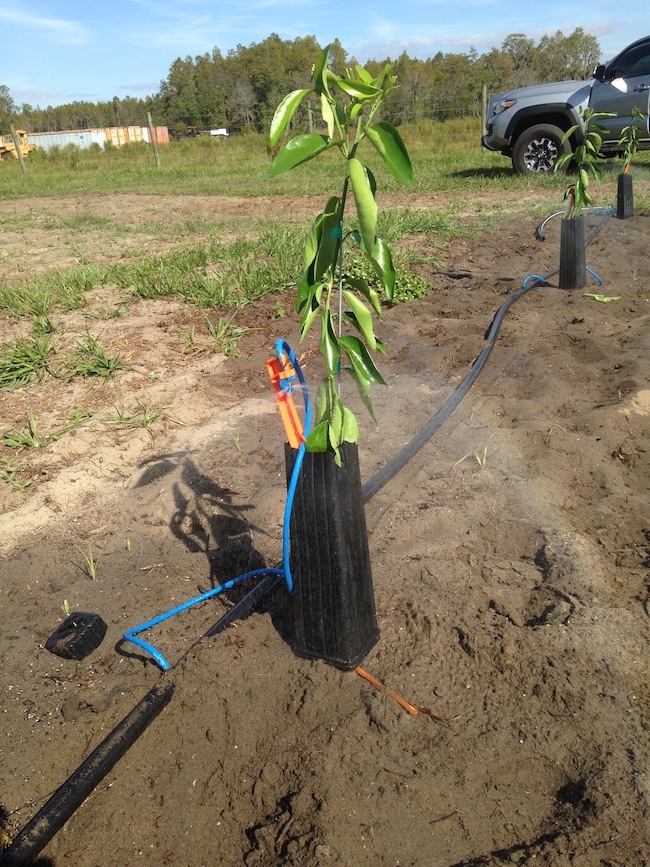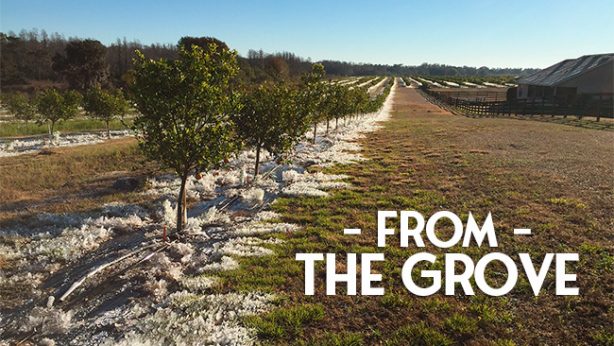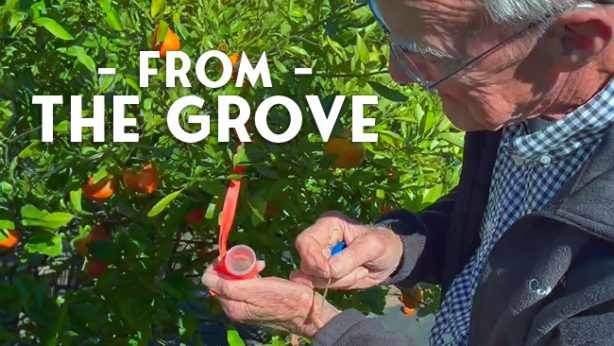From the Grove: All About Irrigation

Irrigation has become a life saver for citrus since its early implementation over a century ago. Over the years, irrigation practices have changed as new technologies and tools made the process more efficient. You may wonder: Why are we talking about irrigation when we were just touting how excited we were about the rain? It all comes back to timing and the effectiveness of irrigation compared to the natural benefits of Mother Nature’s precipitation.
Ben and Benny recently recounted how long it’s been since they’ve seen the groves in this part of Central Florida experience a severe drought. While the summer rainy season is now upon us, we’re still in a rain deficit of about 10 inches year-to-date, and our citrus trees are feeling the effects of the lack of rain. Although we have been actively irrigating the groves, there are shortcomings when compared to how rain can naturally hydrate the soil evenly.
To understand irrigation, let’s start with a history lesson from the early days of irrigating. Farmers back in the day hand irrigated the groves when it didn’t rain. This was extremely time consuming, but also effective. Farmers harnessed the power of mules and early tractor models to dump large amounts of water in wells spanning out in a several foot radius from the citrus tree trunk. The amount of water given to the trees equaled out to about 4-5 inches of rain at a time. In providing all of this water once per month, this was enough to keep the groves thriving — even during a drought. The root stocks used in citrus varieties during this timeframe were also more forgiving of this type of irrigation.
Fast forward several decades, and updated watering technology began to seep into the groves. The 70s and 80s brought about the use of mechanical irrigation. These were raised irrigation sprinklers that towered over the trees. Each acre was supported by seven overhead irrigation sprinklers, and each would water for 24 hours at a time. These sprinklers were great for evenly watering the groves because of the spray field of each sprinkler. This would not only keep the immediate base of the tree hydrated but could span out to water the tree roots that grew out further away from the tree trunk over time.
The industry eventually switched to a different kind of sprinkler system that we currently use today. These are under tree micro sprinklers that became more popular in the 80s and 90s. The overhead sprinklers weren’t cost effective to maintain and were unable to provide cold protection during damaging cold snaps. Under tree sprinklers provide each tree with its own dedicated water source and are great for young tree growth because the roots haven’t spread out as far as mature trees. Additionally, the smaller, directed, concentrated area of irrigation is effective for protecting young trees from cold damage.
Now that many of our trees have reached a mature stage, while individual sprinklers are great to have, there are also some cons to this system. As tree roots have spread, these micro sprinklers don’t cover the same distance to fully wet the expanse of roots. This means an uneven watering that is ultimately limited in its ability to optimally irrigate the trees. In a typical growing season, this wouldn’t be an issue because the sprinklers are only used to supplement small rain deficits when needed. But within the current climate of severe drought, our groves have to overly rely on the irrigation system. Only about a third of the grove’s “floor”, or the total ground that is actually planted, are being watered with micro sprinklers, thus it’s as if some parts of the grove’s ground floor are experiencing true drought conditions, while others are not.
What does this all mean for our crop outlook and harvest at year’s end? While having rain again is great for the overall health of our groves, it’s all about timing. Because we’re now experiencing this rain after the bloom that happened earlier in the spring, this precipitation is too late to have a major impact on this year’s citrus crop. The overdue rain is also delaying the timed release of the organic applications of fertilizers and compost we applied earlier in the season. At this point, we’re preparing to for a smaller than normal crop when we pick citrus between Thanksgiving and Christmas.
Despite mother nature’s setbacks, there is still positive news. The rain we’re currently receiving is setting our groves up for success next year. The rain is helping release the beneficial nutrients provided in our organic fertilizers now which can help the overall health and nourishment of the soil and trees going forward. We’re expecting a strong summer flush meaning fresh shoots and leaves to start sprouting from the branches. We’re planning to plant our legume cover crops in June now that the previously unwetted zones of the grove have received some moisture. These cover crops also help capture carbon and fix nitrogen in the soil organically.
As farmers, we try to have a positive outlook. As we’ve said before, organic farming is not for those who like predictability and routine. We’re constantly learning and adapting to whatever the environment has in mind for us each season with the added challenge of doing this all organically. That’s where our zest for citrus farming comes from!


